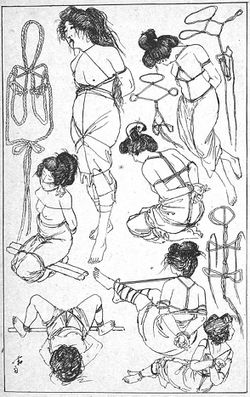テンプレート:緊縛の捕縄術起源論

概要
主に欧米で広がっている「現代緊縛の起源を日本の「捕縄術」に求める」説。欧米人を含め異論を唱える人[注 1]が多い中で、2020年 (令和2年)10月24日に京都大学で開催された『「緊縛ニューウェーブ×アジア人文学」』で、緊縛の捕縄術起源論が研究者から発表され、その後、議論となった(→『シンポジウム「緊縛ニューウェーブ×アジア人文学」騒動』参照)。
戦後、辻村隆、濡木痴夢男、明智伝鬼など、多くの緊縛師が捕縄術の技法を参考にしながら、昭和SMの緊縛スタイルを開発してきた。その意味で、捕縄術は、昭和SMに一定の影響を与えているが、決して捕縄術から昭和SMが誕生したわけではない(→『緊縛の捕縄術起源説』の頁参照)。昭和SMのルーツを伊藤晴雨に求める立場にたつと、伊藤晴雨が実践を始めた大正時代に、どれほどの捕縄術からの影響をうけていたかが問題となる。伊藤晴雨自身が捕縄術を実践していたとする資料は見つかっていないが、捕縄術や江戸時代の公刑であった拷問には、芝居、絵画や小説での責めと同様に興味・知識を持ち合わせていたのは、戦後に書かれた多くの著作物から明らかである。ただし、SM実践を開始した後に書かれた『責の話』(温故書屋, 1929)には「責め」と「拷問」の違いを論じてはいるものの、捕縄術への言及はほぼなく、戦後の改訂版『責の話』(粹古堂, 1952)では、「女の縛り方は公私の別」があるとして、公刑で用いる責めと、個人(私)の楽しみ(性慾)のために使用できる責めを峻別している。伊藤晴雨は、幼少の頃から芝居、絵画、小説の責め場に強い興味を示していたことも考慮すると、SMの誕生に強く影響を与えたのは捕縄術よりはむしろ、芝居、絵画、小説であったと考えるべきである[1]。芝居、絵画、小説の責め場が、捕縄術の影響を受けていたとの指摘もできるが、伝承ではあるが、説教節の『安寿姫』などがすでに責め場を含むことを考えると、「責め」は古来から、文芸モチーフとして存在していたと考えるべきであろう。
昭和SMのルーツを伊藤晴雨に求める立場にたつと、伊藤晴雨が実践を始めた大正時代に、どれほどの捕縄術からの影響をうけていたかが問題となる。伊藤晴雨自身が捕縄術を実践していたとする資料は見つかっていないが、公刑としての縄を用いた捕縄には、芝居、絵画や小説での責めと同様に興味・知識を持ち合わせていたのは、著作物から明らかである。ただし、『責の話』(粹古堂, 1952)で、「女の縛り方は公私の別」があるとしているなど、実践としての責め(緊縛)と、公刑とは区別しており、幼少から慣れ好んでいた芝居、絵画の責め場に影響を受けて実践技法を深めていったものと思われる[1]。伊藤晴雨の同時代には、既に責め(緊縛)愛好家がいたようだが、その情報は伊藤晴雨の著作中に言及されている程度に限られており、それらの人々の中に捕縄術実践者がいたという言及はない。
欧米ではインターネットの普及と共に、1990年代終わり頃から日本の緊縛に感心が集まっていた[1]。その中で『緊縛の捕縄術起源論』が生まれていた可能性があるが、現在、主な引用元となっているのは、Midori/美登里が2001年に出版した "The Seductive Art of Japanese Bondage", Fire Horse Productions, Inc., Eugene, OR (2001)である。Midori/美登里は1980年代から長池士と交流をもっている。Midori/美登里の著作のやや後に発刊された、Master "K"の著作も引用が多い。
主な出来事
1929年(昭和4年)、伊藤晴雨は『責の話』で、自身の雪責めの実践記に加え、何人かの責めの実行者を紹介している。その他は、芝居や小説の中の責め場の解説。
1952年(昭和27年)、『責の話』(粹古堂, 1952)[注 2]の「女の縛り方と責めの方法」では、「女の縛り方は公私の別」があるとし、「公刑の場合は腰縄又は菱縄」「公刑の場合を除けば胸から二の腕にかけて緊しく縛り上げるのが普通」と解説。挿絵の中には本縄と思われる縛りの作品がある。
1953年(昭和28年)4月、奇譚クラブ1953年(昭和28年)4月号の辻村隆・塚本鉄三『後手と高手小手による緊縛美の考察』で捕縄術に影響を受けたことを伺わせる写真が掲載。
1953年(昭和28年)5月、奇譚クラブ1953年(昭和28年)5月号の嶽収一『捕縄雑考』で捕縄術に関する書籍の情報をもとに緊縛実践したことの報告をしている。
2000年(平成12年)、TatuがShibari Source Floridaを創設。『道』に関連させて緊縛を広める。
2001年(平成13年)8月、TatuがYahoo Groupで「Adult Rope Art 」ディスカッション・グループを開始[2]。
2001年(平成13年)、Midori/美登里が "The Seductive Art of Japanese Bondage", Fire Horse Productions, Inc., Eugene, OR (2001)の中で、15世紀の捕縄術の説明の後に、”It's widely believed that our current Japanese erotic rope restraint techniques originated during this period"と表記。
2004年(平成16年)、Master "K"がArt of Shibari" (Secret Publications, 2004)の中で、"Many of the images of modem Japanese S/M are drawn from the times of the Sengoku jidai or War Period of feudal Japan which stretched from 1492 to 1560."と表記。また”In 1742 the Tokugawa government decreed seven different types of official punishments for crimes and four kinds of torture. Two of these, ebizeme (being bound by rope) and tsurizeme (being bound and suspended by rope) became the direct ancestors and inspirations for what would become the shibari art. As Masami Akita accurately observed in his fascinating 1996 study, Nihon Kinbaku Shashin Shi (The History of Bondage Photography in Japan), 'You could say that the foundation of today's S /M art was laid down then.'"と秋田昌美、濡木痴夢男、不二秋夫『日本緊縛写真史 1』 (自由国民社, 1996)を引用。ただし、同書の該当部分の原文は「晴雨はもちろん日本の伝統的な拷問刑罰の研究を行っており、「責めの研究」の中では百二十種\ 二百六十種に分類、命名も行っている。晴雨は吊し、雪責めの他にも、蝋燭責め、海老責め、石抱き、水責め、叩き責め、焼いぶし責め等の実験と撮影に関与したと伝えられるが、その内で最も意欲を燃やしたのは、縛り、吊り、叩き、雪責めの四種類である。」である。
2008年(平成20年)、Master "K"が”The Beauty of Kinbaku" (King Cat Ink, 2008)の中で、15世紀の捕縄術の説明の中で "Regardless of its exact origins, what is clear is that hojojutsu was and is a very effective means of capture and binding and understanding its basic techniques is vital to an understanding of how modern shibari/kinbaku evolved"と述べている。
2009年(平成21年)5月1日、日本在住の米国人SM愛好家KabukiJoeが、自身のサイトSM探偵でMaster "K"にインタビュー。捕縄術との関わりについて掘り下げた質問をしている[3]。下は部分的な抜粋。
- (K, KabukiJoe)"It is said that modern kinbaku comes from hojojutsu. "
- (M, Master "K")"yes, hojojutsu is one, but not the only, important ancestor of modern kinbaku. "
- (略)
- (K)"And you're saying this is still related to hojojutsu?"
- (M)"Of course. These "complex" styles were, as I've just mentioned, part of honnawa hojojutsu and this tradition has been incorporated into modern kinbaku. In the Edo era these ties would be carefully applied with several constables in attendance guarding the prisoner."
- (略)
- (K)"I had always thought that hojojutsu was merely a practical, simple and no-nonsense (albeit codified) method of binding and torturing. No fancy stuff.”
- (M)"Again, your conclusion simply speaks to your lack of access to good information. I show a number of beautiful hojojutsu patterns in my book and I assure you they are all authentic."
- (略)
- (K)"Is there anyone in the modern era who can claim any sort of "lineage" when it comes to shibari?"
- (M)"when Itoh Seiyu began his explorations of seme (torment), we know from the various testimonies of his colleagues and the many study photos and sketches he produced and left behind, that he had learned hojojutsu skills from an original practitioner [注 3]and applied those to his researches. Itoh, in turn, passed on many of these techniques and designs to others, including Minomura Kou (Kita Reiko) [注 4]who was a member of Itoh's circle. Minomura, in turn, influenced Nureki Chimuo and Dan Oniroku and they have influenced many, many more. And so it goes."
2009年(平成21年)、有末剛は海外向けに作られた『有末剛の 緊縛の心と技 1』(十五や, 2009)の中で、"when we think about history of kinbaku, we are obliged to primarily think about a traditional art of capture and binding "捕縛術 or 捕縄術" in Edo period" "I will leave this topic for other practitioners and researchers. The kinbaku I am pursuing is an art of rope bondage, which does not always match the purpose of hobakujutsu which is to capture criminals and make them incapable of escape"と述べている。
引用文献
- ↑ 1.0 1.1 1.2 Ugo "Kinbaku – An Evolving Era – Part 2" in KinbakuToday, 2020.12.20
- ↑ Tatu aka Tatunawa
- ↑ A Seminal Work on Kinbaku
注釈
お役たちweb
- Kinbaku – An Evolving Era – Part 1 in KinbakuToday, 2020.12.15
- Kinbaku – An Evolving Era – Part 2 in KinbakuToday, 2020.12.20